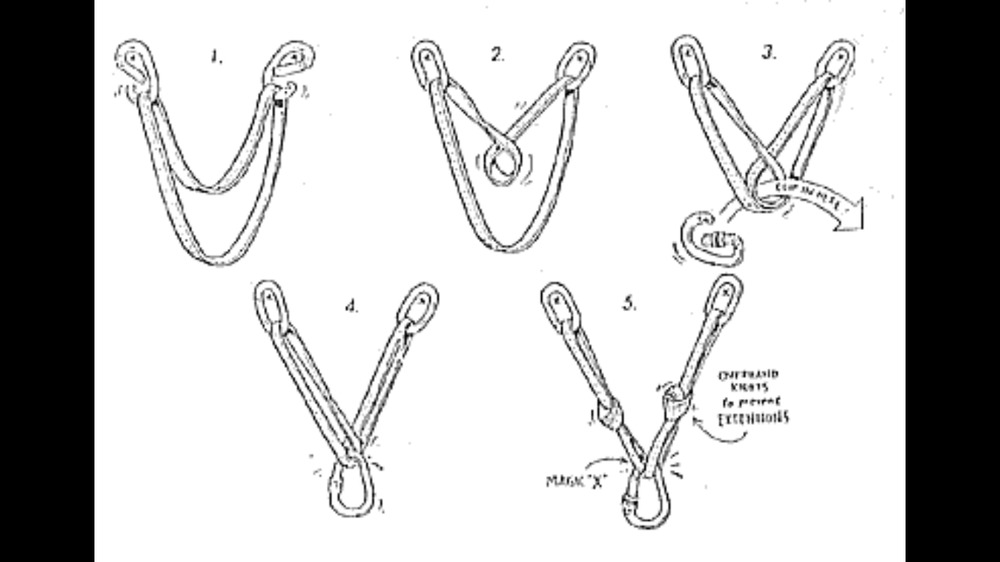Top rope anchor
|
|
|
|
|
Yes. |
|
|
0/10 |
|
|
Sure but at that point you only have no backup in case of failure on one side. |
|
|
The concern that I have for step no. 5 untying the knot would be tough. Any solution to that? |
|
|
Robert Michael wrote: ^^^ |
|
|
Best to just skip step 1. |
|
|
ViperScale . wrote: Not entirely correct. True, no backup for failure of the sling (how likely is that?), but there is backup if one of the bolts fails (and how likely is that?). To the OP: it's far easier to just use a pair of quick draws. Put a locker on each one if you want the added peace of mind. |
|
|
Marc801 C wrote: You might want to look at that bolt failure thread. There are lots of bolt failures out there. Much more than you would think. While you're at it, you should look at the sling failure thread. A rock fell and cut the sling. That's probably more rare. But it happens. I wouldn't recommend forgoing redundancy on the forums. |
|
|
Step 5 makes the anchor non-extending. Which is important. Read up on what a SRENE anchor is and how to build one. There are several ways. The one described above is not my favorite. |
|
|
Greg D wrote: Anchor bolts? On sport climbs?
Hence the recommendation for the far more common use of a pair of QDs. |
|
|
Is the troll still hungry? |
|
|
Marc801 C wrote: Thanks mate for your advise. Will skip step No. 5 then for now. I believe quickdraws is good to use if the length, height of the anchor bolt is equal for this case By any chance there’s tips to untie the knots in step no. 5? I’m afraid ended up with dead knots. |
|
|
Jjensen wrote: You are kidding right? How is that anchor non-extending? Reduced extension does not mean non-extending. The dangers of extension in your typical top rope anchor are pretty minimal. No mass at anchor, so no shock load. No belayer change of angle so no concern there. However why no just tie a single knot? Or use two slings? It accomplishes everything without issue. |
|
|
patto wrote: Good points, so I'll answer them: Why not? - because two slings is slower than one. - because tying a knot is slower when need to untie the full-body-weight loaded knot afterward. patto wrote: > "The dangers of extension in your typical top rope anchor are pretty minimal". Consider that even in the very-very low probability event that a sport anchor bolt would fail while a following climber was climbing (but not already when the Leader was setting up the anchor), the additional length of the fall might be about 2 feet (and anyway the work of yanking the bolt out will absorb some of the fall impact). Ken |
|
|
Greg D wrote: May be rare but also unpredictable. This image always comes to my mind if I see someone skip #5. To the OP...I wouldn't take that chance...such easy ways to avoid this. https://www.mountainproject.com/forum/topic/110088639/rock-fall-results-in-chopped-anchor |
|
|
Marc801 C wrote: The main disadvantage for the simple TR situation might be that you get more abrasion of your rope because the biners on a quick-draw are smaller diameter than what you'd likely use if setting up with a sling. For more complicated TR situations (like leading one climb and then also setting a TR on another route nearby), there is the small (and preventable) possibility that if you have the clipping biners of both QDs ffacing outward, and then climb _above_ the anchor, and then fall, the rope might possibly unclip itself from both QDs (like back-clipping). And for more complicated TR situations, having a sling or two and some bigger locking biners is at least more convenient. Also if you climb at an area that has non-horizontal (vertically-offset) bolts with a pre-installed pigs tail / rams horn lower-off or carabiner for lower-off or rappel ring -- hung from the lower bolt -- and you want to be a good citizen and save wear on the pre-installed hardware, then bringing a sling or two and a locking biner or two seems like a simpler way to do it. Ken |
|
|
/Cuzzo Italiano wrote: If you're worried about it, you could tie figure 8s instead of overhands, which are easier to untie. But I've never had trouble untying overhands in tube webbing/nylon slings unless we spent a reeeaaaally long time on a TR |
|
|
KayJ wrote: Rockfall cutting the sling of a Top-Rope anchor is _not_ "unpredictable". If you always choose to do your Top-Roping on cliffs not exposed to rockfall from above, then it's very predictable that your TR anchor sling will not get chopped. And there are obvious more important reasons _not_ to Top-Rope in situations exposed to rockfall from above. Ken |
|
|
KayJ wrote: I maybe wrong but I thought one of arguments out of that rock fall anchor failure was to use the overhand/figure-eight knot master point. If the rock fall hits the sliding X anchor, it would (in theory) break the both strains between the two limiter knots causing complete failure. While in the master point knot anchor, it would break one side but leave the other side attached. |
|
|
dino74 wrote: You aren't wrong. |

 Continue with onX Maps
Continue with onX Maps Sign in with Facebook
Sign in with Facebook
























